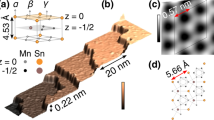Abstract.
Scanning tunneling microscopy and scanning tunneling spectroscopy measurements have been performed on a single crystal of CeRu2 down to 2.2 K under a magnetic field up to 2.0 T. The sample surfaces for the measurements are prepared by cutting or cracking the single crystal at 4.2 K. The vortex lattice has been imaged by mapping the quasiparticle density of states at the Fermi energy on the surface. We have observed that the surface has been covered with microstructures a few nm in diameter. These microstructures are characteristic of the surface when the sample is cut or cracked at low temperature.
Similar content being viewed by others
Author information
Authors and Affiliations
Additional information
Received: 19 July 2000 / Accepted: 14 December 2000 / Published online: 11 April 2001
Rights and permissions
About this article
Cite this article
Sakata, H., Nishida, N., Hedo, M. et al. Scanning tunneling microscopy and spectroscopy on cracked surfaces of superconducting CeRu2. Appl Phys A 72 (Suppl 2), S267–S269 (2001). https://doi.org/10.1007/s003390100657
Issue Date:
DOI: https://doi.org/10.1007/s003390100657




